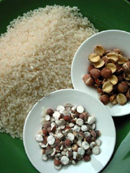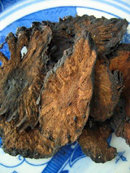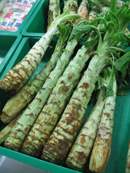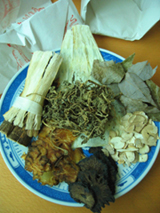| Taking Chinese Diet to Boost Your Fertility Chinese believe proper food intake not only supports the daily nutrient needs, but also cures or relieves health problems via their moderate therapeutic actions. Many food ingredients serve as herbs, for example, job tears, tangerine peel and ginger. They are used to make delicious dishes while at the same time exert medicinal properties. From this, eating the right foods and avoiding the wrong ones can make pregnancy possible.
The way of selecting the right foods is based on syndrome differentiation, so that they fit into the individual's constitution, correspond to the pathological conditions and assist the existing remedy. TCM refers to this as "an application in accordance with the individual, locality, season and disease." According to TCM theory, the blood and qi (vital energy) are the fundamental substances for normal menstruation; they all derive from essence. The kidneys store essence, thus fertility enhancement can start from the kidneys. The Chinese like to eat certain foods to boost the kidneys, such as black fungus, walnut, lotus seed, Euryale seed, Chinese chives, pond loaches, oysters, catfish, maw, sea cucumber, abalone, mutton, beef, venison, sparrows and animal kidneys. Besides these, certain other ingredients may be added into the dishes to ease the disorders associated with infertility such as: |
-
For kidney deficiency: walnut, wolfberry fruit, Chinese yam and black sesame;
-
For stagnation of liver-qi: citron fruit, finger citron and dried tangerine peel;
-
For accumulation of phlegm and dampness: Poria, Job's tears and small red bean.
-
For blood stasis: hawthorn, peach kernel and kelp.
During the menstrual period, it is better to consume warm and cooked foods, and avoid too much food and drinks that are raw, frozen, not easily digested and spicy. This will ensure a smooth menstral flow. Below are some recipes that can be taken on a daily basis to enhance fertility. They also benefit a couple for health maintenance purposes.
|
|
1. Cordyceps and Abalone Soup |
| Ingredients: |
Cordyceps (Chinese Caterpillar fungus) 10g
Fresh mushroom 100
Abalone 100g
Chinese Ham 10g
Rice wine or dry sherry 2 teaspoon
Chicken broth 500ml
Salt to taste
|
Methods: Marinate the cordyceps with rice wine for two hours, and then brush and rinse to clean them; slice the abalone, mushroom and ham into small pieces. Bring the broth to a boil, place all the ingredients in the pot and add 500 ml water to boil again, simmer for approximately 30 minutes or until the ingredients are tender. Add seasonings as desired, simmer 20 minutes and serve hot for two.
Benefits: Cordyceps tonifies the lungs and kidneys; abalone replenishes the essence. The recipe is suitable for infertility accompanied with general weakness, poor appetite and shortness of breath. Individuals suffering from flu or other infections are not recommended to take this soup. |
2. Congee of Euryale Seed and Rice
| Ingredients: |
Euryale seed 50g
Lotus seed 20g
Long grain rice 100g
Salt to taste |
 |
| Euryale seed, lotus seed and rice |
|
Methods: Wash all the ingredients, put them into a saucepan and add 2000ml water; bring quickly to a boil. Reduce the heat but allow the ingredients to remain at a brisk simmer. Place the lid on the pan, leaving it slightly open so the congee doesn't bubble up and spill over. In about one hour the congee is almost done; add salt to taste and serve hot for two.
Benefits: Euryale seed and lotus seed help to consolidate the essence. The three ingredients assist in spleen functioning and promote body fluid production. This recipe is suitable for infertility accompanied with vexation (annoyance) and excessive drinking. |
|
3. Stewed Oyster with Cistanche
| Ingredients: |
Cistanche (Herba Cistanchis) 10g
Dried oyster 250g
Boneless, skinless chicken breasts 200g
Carrots 50g
Rice wine or dry sherry 4 teaspoon
Ginger 6 slices
Green onion, two and diced
Salt and pepper powder to taste |
 |
| Cistanche (Herba Cistanchis) |
|
|
Methods: Soak the Cistanche and oyster fully with water; rinse and slice into strips. Slice the chicken and carrot into pieces. Put the Cistanche, oyster, chicken, carrot, wine and ginger into a stewpot, add water to cover all the ingredients, bring quickly to a boil first and then simmer for 50 minutes. Add seasonings as desired; simmer 20 minutes. Serve hot; this amount is good for four.
Benefits: Cistanche and oyster reinforce the kidneys and replenish the essence and blood. This recipe is for women whose uterus is under functioning, but not suitable when accompanied with digestive problems and hyperactivity of minister fire. |
4. Fried Pork with Wolfberry Fruit
| Ingredients: |
Pork (lean meat) 250g
Wolfberry fruit 20g
Celtuce 100g
Black fungus 20g
White fungus 20g
Vegetable oil 4 tablespoons
Soya sauce 2 teaspoon
Cornstarch 1 teaspoon
Sauce (mixture of 2 teaspoon of cornstarch, sugar 3g, soya sauce 2 teaspoon, rice wine 2 teaspoon and 4 tablespoons chicken broth)
Green onion, two and diced
Ginger 5g, sliced
Salt to taste |
 |
| Celtuce |
|
|
| |
|
Methods: Slice the pork into strips; peel the celtuce and slice into strips; soak the black and white fungus with warm water for 30 minutes; rinse and slice into strips; the wolfberry should be rinsed too. Put the pork strips in a bowl, mix with starch and soya sauce, put aside and marinate for a few minutes. Preheat a pan; pour in the vegetable oil for stir-frying. When the oil is hot, add the ginger and green onion, stir-fry briefly until its flavor is released. Put in the pork; fry until the meat turns brown. Add in the wolfberry, celtuce, black and white fungus, fry for another 3 minutes; add in the sauce and cook for 2 minutes and serve. This amount is good for two.
Benefits: The wolfberry reinforces the liver and kidney functions, and replenishes the essence. The celtuce and fungi clear the toxins in the blood. This recipe is suitable for women who are under-functioning in the reproductive system; however, it is not advisable for individuals suffering from fever, diarrhea or digestive problems. |
5. Epimedium Tincture |
| Ingredients: |
| Herba Epimedii |
Epimedium |
100g |
 |
| Ingredients for Epimedium tincture |
|
| Herba Cistanchis |
Cistanche |
30g |
| Herba Leonuri |
Motherwort herb |
30g |
| Radix Angelicae Sinensis |
Chinese angelica root |
30g |
| Radix Ligustici Chuanxiong |
Szechuan lovage |
30g |
| Radix Paeoniae Rubra |
Red peony root |
30g |
| Radix Linderae |
Combined Spicebush root |
30g |
|
Methods: Cook all the ingredients by steaming method for about 30 minutes, and then put aside to let them cool down. Put the ingredients into a large vessel; pour in 500 ml of rice wine and 500 ml of liqueur; seal the cover properly. Place the vessel in a warm place (25°C). It will be ready to serve, after being soaked for three to five days. Take 25 ml every night before sleep.
Benefits: Alcohol preserves the potency of herbs in a convenient form and is a beneficial ingredient on its own, which makes it an excellent base for herbal tinctures. The above ingredients activate the blood and qi circulations, fortify the kidneys and regulate the menstrual period. It is suitable for infertility due to kidney deficiency. |
|